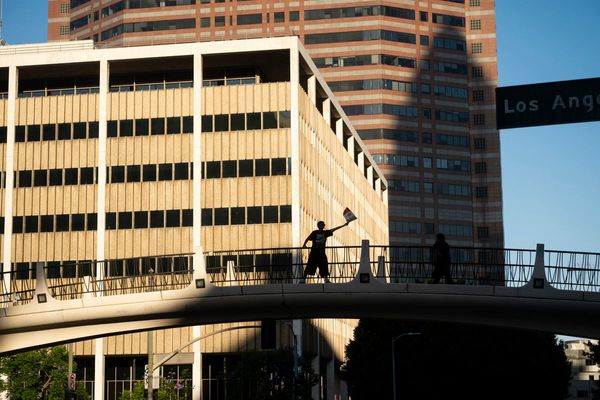
What if the Franklin river hadn’t been saved?
Stopping the Gordon-below-Franklin dam was one of the Australian environment movement’s great victories: in the late 1970s, the state-owned Hydro-Electric Commission wanted to flood one of three last temperate rainforests in the southern hemisphere to create a power station.
About 33km of the Franklin, a pristine wild river home to breathtaking ravines and rapids, and surrounded by untouched Huon pine and myrtle beech forest, would have drowned. After years of heated debate, pro-dam Liberal Robin Gray took power in 1982 and passed legislation allowing construction to begin. What happened from there was partly down to luck and timing, but could not have been achieved without one of Australia’s most successful acts of mass civil disobedience.
An estimated 6,000 people headed to the town of Strahan to join the protest, and nearly 1,500 were arrested on the river. Rallies and newspaper ads helped build an extraordinary level of buy-in throughout Australia. At a byelection for the Victorian federal seat of Flinders, 41% of voters scribbled “No Dams” on their ballot paper.
The momentum was such that the incoming prime minister, Bob Hawke, pledged in March 1983 to stop the dam, a stance narrowly backed by the high court. In economic terms, the arguments for the dam now seem thin – the 180 MW plant would have increased energy capacity by only 14% while leaving the state with a disproportionate debt.
Yet it is easy to imagine circumstances in which the damming would have gone ahead. For instance, if the fight over the Franklin was happening not 35 years ago, but today.
Guardian Australia interviewed 20 campaigners and political veterans and found broad – though not unanimous – agreement that a project similar to the Gordon-below-Franklin dam in scale and impact would be near impossible to stop now.
Legally and politically, they say environmental protection is harder to win than at any time since before the wave of landmark 1980s decisions to recognise the Daintree rainforest and Kakadu national park and to block mining in Antarctica.
Bob Brown, whose role in saving the Franklin launched him onto the national stage, believes the campaign would now fall at multiple hurdles: it would be unlikely to win crucial government backing for world heritage listing, as it did in 1982 under the Liberal prime minister Malcolm Fraser; that no political leader since had shown Hawke’s willingness to prioritise the environment over development; above all, that activists would be highly unlikely to turn out in large numbers given increased risk of serious fines or other criminal penalties.
The last point is key, he says, as it would deny a campaign momentum.
While Brown won a recent high court case that struck down harsh Tasmanian forestry laws that threatened fines of up to $10,000 and up to four years jail for anyone obstructing a “business activity”, that judgment was as much about the shoddy way in which the laws were written as the principle. The court found the aims of the laws were legitimate. The former Greens leader believes laws challenging peaceful protest will return.
“The Franklin would be dammed if it were today,” Brown says. “It would be just a dead moat around [nearby peak] Frenchman’s Cap.”
While Labor governments are not spared criticism, the broad consensus among those interviewed was that environmental protection has reduced sharply since the federal Coalition won power in 2013.
Former Labor environment minister and activist Peter Garrett says the standard of environment policymaking and protection in Australia has reached a nadir. He cites two reasons – a lack of political will, and conservative environment ministers not having the capacity to prioritise nature. “It comes about partly because of the ideological fixations of the right, and because the current government has chosen to allow the environment to become an invisible issue,” he says.
Some recent headline-grabbing cases of loss of environmental protection in the name of helping industry or agriculture are easy to identify: a staggering increase in land clearing in Queensland; a proposed 400,000 sq km reduction in marine park high-protection areas; Australia becoming the first country to abolish a carbon price that required business to pay for its carbon dioxide emissions.
Other changes are more complicated, and sometimes less visible.
Environmental activists are facing what they say is a multipronged attack to limit green groups’ ability to run campaigns and be involved in political advocacy.

Photograph: Getty Images/iStockphoto
The Abbott government initially launched a failed attempt to amend national environmental laws so green groups based outside the immediately affected area would no longer have the right to challenge development decisions in court. That right had been used to overturn several flawed government approvals – for example, allowing logging in Tasmania’s Wielangta forest without considering the cumulative impact on three threatened species across a wider area. The plan to abolish it failed to pass the Senate.
The government then wanted to limit the right to receive tax deductible donations – a significant source of revenue – to environment groups that dedicated at least 25% of spending to “practical” work in the community. That plan was dropped in December when industry support evaporated. It has been replaced with a new push announced under the banner of outlawing foreign donations, but that actually goes much further.
It would significantly increase the administrative work required by any group that spends more than $100,000 on “political expenditure” in a year. The definition of “political expenditure” might be described as broad: any work that includes public expression on an issue “that is, or is likely to be, before electors in an election”, even if an election has not been called.
Why is Australia concerned about foreign donations?
The government announced a review into political donations in 2016 after then-Labor senator Sam Dastyari asked a Chinese businessman to cover a travel overspend. The Liberal-National Coalition and Labor opposition agreed on the need to ban foreign donations, although Labor opposed the ban covering third-party campaign groups.
What are the proposed changes?
In December the government introduced legislation banning foreign donations to political parties and activist groups. The electoral funding and disclosure reform bill requires charities to hold those donations in separate bank accounts to ensure they are not spent on advocacy. It requires lobbyists working for foreign interests to register. Separate bills would criminalise support for foreign intelligence agencies and leaks of harmful information; introduce new sabotage provisions and theft-of-trade-secrets offences aimed at economic espionage by foreign governments.
Why are some groups worried about the changes?
Charities worry the new requirements will force them to stop advocacy work or divert resources from frontline services. Other groups have warned the secrecy provisions could see government whistleblowers and journalists who report leaks facing 20 years’ imprisonment. Academics say the bill may breach the implied freedom of political communication in the constitution.
Does the law only deal with foreign influence?
Critics of the package are concerned it makes unrelated changes to electoral law including:
• A new definition of “associated entity” forcing campaign groups to register as associated with political parties; and
• Changed election funding offering political parties that win 4% or more of the vote the lesser of $2.70 per vote in public funding or the amount of their electoral expenditure.
Legal advice seen by Guardian Australia suggests it is likely to require groups to tally how much they spend in time and resources on submissions or evidence given to parliamentary inquiries, any communication with a United Nations body, any opinion expressed about a political party. If it is more than $100,000 they would be branded a “political organisation”, rather than members of civil society.
Registered charities – including most environment groups – would need to set up separate bank accounts for money to be spent on political advocacy and direct environmental works, and report the political party membership of senior staff. All groups would be required to nominate a financial controller who could face up to 10 years in prison and fines up to $210,000 if they breached their responsibilities.
The Human Rights Law Centre said the harsh penalties meant groups were likely to err on the side of caution. “This could cause a chilling effect, where organisations steer clear of voicing views on any matter publicly,” it says.
In the same week, the government put Keating-era Labor cabinet minister Gary Johns – a consistent critic of non-government organisations who believes charities should be barred from advocacy – in charge of ensuring they comply with the law, with powers to redraw rules governing the sector.
In a briefing note, the Australian Conservation Foundation says the proposed changes are part of a blatant attempt to shut down environmental opposition to government policies.
“This will be dressed up as ‘levelling the playing field’ or ‘cleaning up the money in politics’ but it is actually the silencing of civil society, and will prevent many charities from effectively pursuing their missions,” it says.
While green groups are under pressure, funding for government environment and biodiversity programs has been slashed. This isn’t a new phenomenon – there have been notable cuts under governments of both stripes – but, as Guardian Australia revealed last month, they have been particularly sharp under this federal Coalition.
Analysis by the Australian Conservation Foundation found spending on environment department programs and staff suffered a 33% cut (from $1.4bn in 2013-14 to $945m in the last budget). Forward projections included in the budget papers promise deeper cuts into next decade.
Australian Conservation Foundation policy analyst James Trezise, who worked at the federal environment department until 2014, says biodiversity conservation and monitoring and auditing programs has suffered.
“There are good people in there who want to do good work to ensure the environment is protected,” Trezise says. “But they are heavily constrained by a government that has deprioritised the environment, by serious resource cuts and a lack of ambition in implementing policy and legislation.”
Any discussion of the state of environmental protection and natural resource management returns to the use of the national environmental laws introduced by the Howard government.
The Environment Protection and Biodiversity Conservation Act (EPBCA) was divisive when it came into effect in 2000. Promised as a framework to protect biodiversity and matters of national environmental significance, it was welcomed by some for gathering decision-making powers previously spread across different ministerial portfolios under the environment minister. Others objected to the near total level of discretion it gives whoever is environment minister at any given time in deciding how to apply the law.
It is less divisive now. There is a strong view across the community, from green groups to the business community, that the act is not fit for purpose in its current form.
Since the Coalition was elected in 2013 it has used the act to stop only one development: a pair of wind turbines on Lord Howe Island that were blocked last year due to their “intrusive visual impact”.
The Wilderness Society national campaigns director Lyndon Schneiders says the legislation is ill-conceived and weak, having been designed as a form of triage – to maintain the minimum viable population of a species through conditions and offsets – while allowing proposals to go ahead.
“There is no underlying principle in the act to say it is to protect the environment. It’s not – it’s to manage development,” he says.
Nicola Beynon, head of campaigns with Humane Society International, is more positive – “it’s a good piece of legislation” – but says it is weakened by the extent to which the minister can decided how it is used. She gives the example of offset provisions.
“The way ecology works you can’t just replace it somewhere else, but these days they have even abandoned the concept of trying to replace like for like,” he says. “Now it can be replaced with another species. The net effect is you lose biodiversity over time.”
Some are positive about what the existing law can deliver. Of the 20 proposed developments stopped using the act, 13 were by Garrett in the less than three years he was minister. The Midnight Oil frontman says: “Under a strong minister with political support in the cabinet it’s still better than most acts in most countries.” But everyone interviewed agreed it should be revamped or replaced. A review by former public servant Allan Hawke commissioned by Garrett recommended in 2009 a raft of changes to toughen and streamline the law, but they have not been acted on.
The man who oversaw the act’s introduction, former Liberal environment minister Robert Hill, says the law was regarded as world’s best practice when it came in and that he has not seen advances on it elsewhere, but agrees there is a case for change.
“It’s been nearly 20 years. I have assumed there will be a new evolution. I’ve been expecting it and I know various law reform bodies have been thinking about it,” he says.
He warns against judging the legislation on the number of developments blocked as the primary goal was to ensure the best environmental outcomes when they were approved, but adds: “I don’t know the act has always been employed as rigorously as I would have liked to have seen.” He declines to say it when it could have been better used.
Hill is an ambassador for Conservatives for Conservation, a Coalition-aligned group making the case for environmental protection from the centre-right. He does not agree the big decisions of the 1980s would not be made now – the act makes them easier to achieve, he says. But he does not support the targeting of environment and other civil society groups. “I wasn’t demanding it. I thought it was working OK.”
The act’s current custodian, environment minister Josh Frydenberg, says the existing law is still the best national mechanism to protect important and sensitive environment matters. He says it has “ensured Australia has remained at the forefront of global best practice” in meeting its international obligations for migratory species, wildlife trade and world heritage.
Many of those interviewed say there has been a cultural shift, that there was once bipartisan agreement that protecting the environment was a public good, but that has disappeared as public life has become more ideological and parliament drawn from a narrower cross-section of the community.

Environment Victoria chief executive Mark Wakeham says: “It has become a badge of honour for many Coalition MPs to beat up on the environment. That wasn’t always the case.”
Judy Lambert has watched the change since her time in Canberra in the 1980s and 1990s, first as a national liaison officer with the Wilderness Society and later a non-political technical advisor to Labor minister Ros Kelly.
“The extremes are more extreme than they were. You used to be able to go and speak to political offices on both sides to discuss issues, whether you agreed or disagreed. I don’t think that would be possible now,” she says.
“It feels to me that we’ve lost the commitment to good science, or good technical expertise of any sort.”
Lambert says there was a noticeable shift in the 1990s when industry lobbyists began to borrow techniques used in environmental campaigns to build community support for their position. Employed successfully, it helped shift the weight in decision-making discussions towards short-term economic gain over longer-term environmental benefits.
It coincided with a dramatic growth in the number of industry-backed lobbyists employed to make their case in Canberra. At the same time, the number of professional environmental activists based in the capital has been cut in half since late last century.
In the face of this, the green movement will campaign this year for an overhaul of national environment laws, coming together under the banner Places You Love.
Don Henry, who campaigned for years as the head of the Australian Conservation Foundation and is now professor at the University of Melbourne, is optimistic about the chances of success.
Unlike others interviewed, he believes the big environmental wins of the 1980s could be landed today. Research shows the majority of Australians care deeply about the environment. If that can be tapped into, the political will would follow.
“People are now much more aware how important clean air, clean water and the environment is than they were 40 or 50 years ago,” he says. “What we don’t have in place at the moment in Australia is a 21st-century suite of environment laws, and it is about time we did.”







